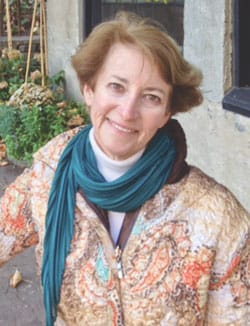Gluten intolerance and celiac disease

Castle Pines Village resident Barb Gschwendtner is one of thousandswho suffer from celiac disease. Fortunately, many local restaurants offer gluten-free meal choices,
making it much easier to eat out.
Article and photo by Joe Gschwendtner
I live with a celiac. That is to say, I live with Barb, my wife of 45 years who is afflicted with the hereditary celiac disease. Diagnosed by blood tests in 2003, her diet has been forever altered to ensure the autoimmune condition does not worsen and to eliminate symptoms, which have a misery all their own.
In 1944, Barb’s sister Virginia was born a “banana baby.” Mysteriously unable to keep any food in her tiny body, bananas saved her life. Little was then understood about an autoimmune disease that would not allow her to absorb certain protein elements, in the aggregate called “gluten.”
Until diagnosed as celiac, Virginia’s and Barb’s brother Chuck believed that everyone suffered abdominal cramping, erratic episodes of diarrhea, weight loss, weakness, and fatigue, but just didn’t talk about it. By 2003 when Mom was determined to also be celiac, the family discovered the genetically-linked disorder affected five of seven children in the family.
Non-hereditary gluten intolerance causes identically symptomatic reactions and is not to be taken with less gravity. As with celiac, there is no cure. A diet including wheat, barley or rye (and some oats) will damage the villi of the small intestine with cumulative and potentially devastating effect. The Celiac Sprue Association estimates celiac affects three million Americans but that only roughly 150,000 of them know it, and another 18,000,000 are gluten intolerant. Gluten intolerance awareness is job one for CSA and much work remains to be done.
Now for the good news. A proper diet can limit damage and mitigate or eliminate painful symptoms. A gluten-free diet is also surprisingly healthy and offers benefits beyond simply controlling the symptoms. Awareness of the disease in the United States is becoming greater. The restaurant industry leads the way, many with listings of gluten-free dishes. More enlightened chefs are capable of modifying many of their signature recipes to safely serve the gluten-intolerant community.
The food industry is waking up too. Those in the forefront list products as gluten free on the label. Those concerned about liability wordsmith ingredients conservatively or in such a manner that gluten conclusions cannot be readily drawn. This too will change when awareness of the condition is universal.
If some of the aforementioned problems are symptoms you frequently experience, check with your general practitioner. Celiac is a one percent probability; gluten intolerance is six percent. A simple blood test can point the way to a life lived differently, but safer and much more comfortably. Pleasure can be restored to eating, no small reward for anyone.
For more information see www.csaceliacs.info.